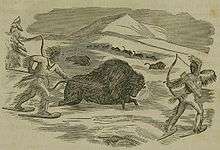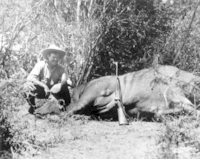Big-game hunting
Big-game hunting is the hunting of large game, almost always large terrestrial mammals, for meat, other animal by-products (such as horn or bone), trophy or sport. The term is historically associated with the hunting of Africa's "Big Five" game (lion, African elephant, Cape buffalo, leopard and rhinoceros), and with tigers and rhinoceroses on the Indian subcontinent. Along with the big five animals, many other species are hunted including kudu, antelope, and hartebeest. Moose, elk, caribou, bison, mule deer and white-tailed deer are the largest game hunted in North America, which is where most big-game hunting is conducted today.
Big-game hunting is conducted in Africa, North America, South America, Europe, Asia and Australia. In Africa, lion, Cape buffalo, elephant, giraffe and other large game animals are hunted. In North America, animals such as bear, wolf, caribou, moose, elk, alligator, boar, sheep and bison are hunted. In South America, deer and other species are hunted. In Europe, sheep, boar, goats, elk, deer, and other species are hunted. In Asia, several species of deer, bear, sheep and other species are hunted. In Australia, several species of deer and wild boar are hunted.
History
Hunting of big game for food is an ancient practice,[1] dating back thousands of years. It is associated in Europe with the appearance of the Aurignacian culture, although bone fractures on Neanerthal fossils suggest a possible earlier appearance. Based on cave paintings, it appears that early man hunted mammoth in groups, using a combination of spears or large rocks, or alternatively running the animal off a cliff.

Methods
Various big-game hunting methods have been developed over centuries. The main methods in use today are stalking, ambush (hunting from blinds), driving, trapping or a combination thereof. Calling and baiting may be used to increase the effectiveness of any method or combination.
The stalking method[2] consists of following the animal until the kill can be made. Generally the hunter approaches the game stealthily - camouflaging his appearance, scent or sound depending on which sense is most likely to reveal him to his prey under the conditions. Stalks can routinely persist for days for certain game under certain conditions. Tracking game for stalking is a skill that has been learned by hunters since pre-historic times, and is used to with great success today.
The ambush method,[3] including hunting from blinds, consists of setting up or finding means of cover or concealment to assist in reducing the likelihood of the game detecting the hunter as he waits in ambush or approaches his prey. Ground blinds, tree stands, cocking-cloths,[4] dugout blinds, and stand-alone structures are all used as blinds in hunting today. All of these blinds are used in the ambush method. Cocking-cloths, or stalking blinds, are used in stalking prey but may still be considered as an ambush. Generally, baiting big-game includes the use of blinds; all the methods described herein may be used in combination.
Driving game, as a hunting method, is the act of directing the movement of the animal in order to kill it. Game may be driven to a trap; to a fall that will kill it, such as over a cliff; or to a position where the hunter may make the kill with his weapon. Driving is accomplished by sending an agent, usually dogs or people, through the terrain where the animal is believed to be, and making enough noise or using other devices to push the animal to move in the desired direction.
The use of vehicles in stalking and driving game can increase the hunter's range and speed, and therefore, his effectiveness. Vehicles may also be used as blinds. Ground and air vehicles have been used in hunting big game, both for scouting game location and for the stalk.
Weaponry

Portable weapons used for big-game hunting include firearms, bow and arrow, spears, atlatls, and other longer-range weapons, as well as close-range, handheld weapons like hammers, axes, knives and other bladed weapons.
By far the most common weapon used by hunters is the firearm, and among firearms the most common weapon is the long-barreled rifle. Other firearms, such as shotguns and handguns, are also used in big-game hunting.
Large-caliber ammunition is considered to be most effective in taking down large game effectively and humanely. Big-game hunting ethics require a clean, humane kill, and most hunters work diligently toward this end.[5] Advances in ammunition and the guns to match have made longer-range kills of big game possible with margins of error considered tolerable. Some common calibers and types of ammunition for big-game hunting include .30-30 Winchester, .30-06 Springfield, .300 Winchester Magnum, and .358 Winchester. The calibers and types of ammunition, and the firearms to shoot them, are numerous, and the science of ballistics is continuously improving to allow hunting in a tremendous variety of situations. Bullet weight and shape, cartridge size, powder load and type, and virtually every other variable of firearms ammunition is continuously changing.
Bow and arrow hunting is popular and effective among skilled hunters for big game. There is a variety of types of bows available, including long bows, short bows, recurve bows, compound bows and crossbows, all made of various materials. Arrows are also made from various materials including wood, fiberglass, carbon fiber and others. Arrowheads have different configurations and materials as well.
Primitive hunting using spears, atlatls and other weapons is a skill popular among hunters seeking greater challenge and knowledge than more conventional weaponry.[6]
Hunting ethics
With greater competition among hunters and given increasingly scarce resources, the need for ethical behavior from big game hunters has increased proportionately. The Boone and Crockett Club and Pope and Young Club (for bow hunters) both promote Fair chase hunting. The Spanish philosopher José Ortega y Gasset in his famous book Meditations on Hunting promoted a mindful approach to hunting. Author James Posewitz in his book Beyond Fair Chase: The Ethic and Tradition of Hunting, wrote:
Fundamental to ethical hunting is the idea of fair chase. This concept addresses the balance between the hunter and the hunted. It is a balance that allows hunters to occasionally succeed while animals generally avoid being taken.[7]
Another author, Allen Morris Jones, in his book A Quiet Place Of Violence: Hunting and Ethics in the Missouri River Breaks, argues that hunting is right insofar as it returns us to the natural context from which we evolved, and wrong insofar as it further removes us.[8] Even in the context of trophy hunting, we must eat what we kill, for instance, given that our evolved role was one of predation.
Famous big-game hunters
Africa
- W.D.M. Bell (later known as “Karamojo” Bell), Scottish born elephant hunter[9]
- John Henry Patterson (killed the Tsavo Man-Eaters)
- Frederick Russell Burnham (Lord Roberts' Chief of Scouts in the Second Boer War and known as: England's American Scout)
- Bror von Blixen-Finecke (who was, between 1914 and 1926, married to Out of Africa author Karen Blixen)
- Denys Finch-Hatton (who was, after her marriage collapsed, Karen Blixen's lover)
- T.R.M. Howard (civil rights leader, entrepreneur, surgeon, mentor to Medgar Evers and Fannie Lou Hamer, hunted African big game in the 1960s and 1970)
- John A. Hunter
- Philip Percival
- Frank M. "Bunny" Allen, whose safaris with Ernest Hemingway led the author to write Green Hills of Africa, True at First Light, The Short Happy Life of Francis Macomber, and The Snows of Kilimanjaro
- Theodore Roosevelt, US President who travelled and hunted in Africa following his terms in office
- Frederick Selous
- Peter Hathaway Capstick, American hunter who spent most of his life in Africa
- Bali Mauladad, the only non-white to be admitted to the East African Professional Hunter's Association
Asia
- Britain's King George V hunted in Nepal in 1911.
- Ibrahim of Johor who began shooting in the summer of 1897 and by 1898 killed his first tiger on foot.
- Jim Corbett, author of Man-Eaters of Kumaon
- Samuel Baker
- Kenneth Anderson 1910–1974, hunter and writer of Nine Maneaters And One Rogue (1954)
North America
See also
References
- ↑ "Big-game hunting has a long and storied history". Pittsburgh Post-Gazette. Retrieved 2015-11-10.
- ↑ "Spot And Stalk: The Art of Hunting on Foot - Bowhunter". Bowhunter. Retrieved 2015-11-10.
- ↑ "Earliest evidence for ambush hunting by early humans in the Kenyan Rift". phys.org. Retrieved 2015-11-10.
- ↑ "Hunting Blind History". mbush Hunting Blinds. Retrieved 7 July 2016.
- ↑ "Boone and Crockett Club | Hunting Ethics | Wildlife Conservation | Deer Hunting | Elk Hunting | Big Game Hunting". www.boone-crockett.org. Retrieved 2015-11-10.
- ↑ "Learn Primitive Hunting Skills With MDC Course In Columbia". LakeExpo.com. Retrieved 2015-11-10.
- ↑ Posewitz, Jim (1 August 1994). Beyond Fair Chase: The Ethic and Tradition of Hunting . Globe Pequot Press. p. 57. ISBN 9781560442837.
- ↑ http://www.fieldandstream.com/blogs/conservationist/2012/08/book-makes-you-understand-why-you-need-hunt
- ↑ "Oxfordjournals.org". Retrieved 2011-10-10.
Further reading
- Foa, E. After Big Game in Central Africa. St. Martin's Press. ISBN 0-312-03274-9.
- Herne, Brian. White Hunters: The Golden Age of African Safari, Henry Holt & Co, New York, 1999.
- "The Most Dangerous Game", a classic story famous in the mid-twentieth century that was inspired by and explores the philosophy of hunting for sheer pleasure.
- Hemingway, Ernest. Green Hills of Africa
- Hemingway, Ernest. True at First Light
- Roosevelt, Theodore. Good Hunting: In the Pursuit of Big Game in the West ISBN 978-1628737974.
External links
| Look up big game in Wiktionary, the free dictionary. |